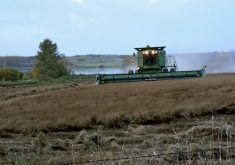Winnipeg — Cool, wet weather continued to delay harvest operations across Saskatchewan in early September, according to the latest crop report from the provincial agriculture ministry.
As of September 1, seven percent of the crop was harvested, while 28 percent was swathed or ready to straight cut. The week prior, two percent of the crop was combined and 12 percent of the crop was swathed or ready to straight cut. The five-year average for this time of year is 14 percent combined and 23 percent swathed or ready to straight cut, the report said.
Read Also

Canadian Grain Commission to use surplus to avoid fee increases
The Canadian Grain Commission will continue to use its surplus to cover budget shortfalls and avoid potential fee increases until 2028, the federal agency announced Monday, Oct. 27.
The southwest region saw the most harvesting activity during the week, with 17 percent of the crop combined. Seven percent of the crop was harvested in the southeast, six percent in the west-central region, three percent in the east-central and twoper cent in the northwest.
Fall rye crops continued to be the furthest along at 65 percent combined, while 42 percent of field peas were harvested and 32 percent of the winter wheat was off the field.
Many crops saw little to no combining as of September 1, with canaryseed, soybeans and flax remaining at zero percent harvested. Spring wheat, oats, durum, canola and chickpeas were all one to two percent harvested. Fifty-three percent of the canola was swathed.
Rainfall amounts varied during the week, ranging from none to 63 mm in some southern areas. Topsoil moisture was rated as 24 percent surplus, 74 percent adequate and two percent short on crop land. On hay land and pasture, topsoil moisture was 16 percent surplus, 80 percent adequate and four percent short.
Pasture conditions were rated as 21 percent excellent, 65 percent good, 12 percent fair and two percent poor. Most livestock producers say they have enough water supplies. Reports indicate that seven percent of the forage crops did not get cut or baled due to excess moisture and dry-down issues.
Any damage seen during the week was likely linked to hail, heavy rains, flooding and strong winds, as the extreme conditions caused lodging in many crops. There are quality concerns with some pulses and cereals, according to the report.














